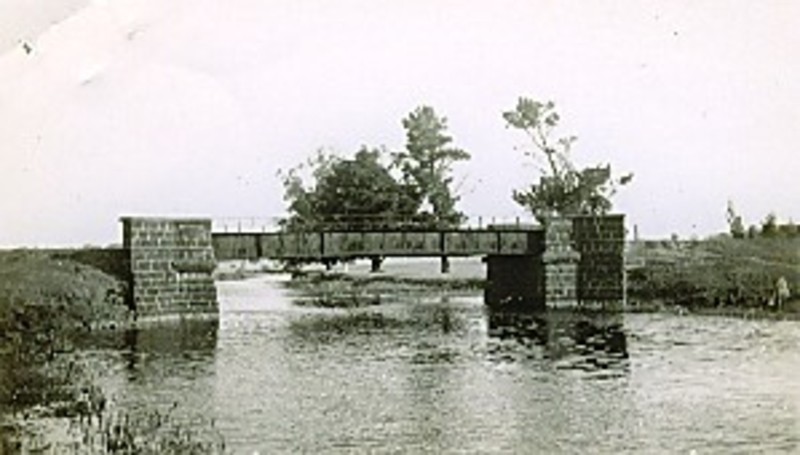Back to search results
Hotspur Bridge over Crawford River
Portland-Casterton Road,, HOTSPUR VIC 3303 - Property No B2212
Hotspur Bridge over Crawford River
Portland-Casterton Road,, HOTSPUR VIC 3303 - Property No B2212
All information on this page is maintained by National Trust.
Click below for their website and contact details.
National Trust
-
Add to tour
You must log in to do that.
-
Share
-
Shortlist place
You must log in to do that.
- Download report

B2212 Hotspur Bridge

On this page:
Statement of Significance
The Hotspur wrought-iron plate-girder road bridge of 1870 is historically and scientifically significant at State level.
Any extant Victorian road bridge whose origins predate the devastating state-wide floods of the spring of 1870, and which retains a high degree of structural integrity, has a prima facie claim to be of historical significance at State level. Such bridges are extremely few. Had this bridge not been unusually strong it would probably have gone the way of so many other rural Victorian river bridges in the 1870 floods.
This bridge is the oldest surviving example of a rural Victorian wrought-iron plate-girder road bridge. It combines iron girders with stone-masonry abutments and a timber deck. When constructed early in 1870 on the advice of a state government inspecting engineer at Warrnambool, it represented a futuristic design for a 'permanent bridge' in a municipal world that still thought in terms of 'economical' all-timber road bridges. Such an expensive design could only then be contemplated in Portland Shire, when it was known that there would be substantial subsidies from the State. It is a surviving relic of a once-important overland pastoral route that connected much of western and north-western Victoria with the coastal port of Portland, in a pre-rail era.
The only older wrought-iron road bridges known to survive in Victoria are the Hawthorn (1861) and Redesdale (1868) wrought-iron lattice-truss bridges, and the Keilor wrought-iron box-girder bridge (1868). Those bridges are considerably larger to meet much more difficult engineering challenges, and the design of their iron girders puts them into different structural categories. Although Victoria has several extant later colonial plate-girder bridges, mainly over large rivers at key transport centres, they cannot really be compared to this modest but unusual early rural example with its half-through design. This is the only known surviving Victorian example of a half-through wrought-iron plate-girder road bridge. It is also unusual for colonial iron road bridges with timber decks to have supporting cross-girders of iron, tying the whole structure.
Colonial iron road bridges designed prior to 1870 are now extremely rare, which makes this an important historical artifact. Its relatively primitive wrought-iron technology clearly distinguishes this bridge from all other Victorian road bridges. It was the first large iron-work contract to be undertaken by a Portland contractor. Visually, its unusual and decorative iron hand-rails and its slightly 'haunched' profile add to the bridge's distinctiveness.
Classified: 05/06/2000
Any extant Victorian road bridge whose origins predate the devastating state-wide floods of the spring of 1870, and which retains a high degree of structural integrity, has a prima facie claim to be of historical significance at State level. Such bridges are extremely few. Had this bridge not been unusually strong it would probably have gone the way of so many other rural Victorian river bridges in the 1870 floods.
This bridge is the oldest surviving example of a rural Victorian wrought-iron plate-girder road bridge. It combines iron girders with stone-masonry abutments and a timber deck. When constructed early in 1870 on the advice of a state government inspecting engineer at Warrnambool, it represented a futuristic design for a 'permanent bridge' in a municipal world that still thought in terms of 'economical' all-timber road bridges. Such an expensive design could only then be contemplated in Portland Shire, when it was known that there would be substantial subsidies from the State. It is a surviving relic of a once-important overland pastoral route that connected much of western and north-western Victoria with the coastal port of Portland, in a pre-rail era.
The only older wrought-iron road bridges known to survive in Victoria are the Hawthorn (1861) and Redesdale (1868) wrought-iron lattice-truss bridges, and the Keilor wrought-iron box-girder bridge (1868). Those bridges are considerably larger to meet much more difficult engineering challenges, and the design of their iron girders puts them into different structural categories. Although Victoria has several extant later colonial plate-girder bridges, mainly over large rivers at key transport centres, they cannot really be compared to this modest but unusual early rural example with its half-through design. This is the only known surviving Victorian example of a half-through wrought-iron plate-girder road bridge. It is also unusual for colonial iron road bridges with timber decks to have supporting cross-girders of iron, tying the whole structure.
Colonial iron road bridges designed prior to 1870 are now extremely rare, which makes this an important historical artifact. Its relatively primitive wrought-iron technology clearly distinguishes this bridge from all other Victorian road bridges. It was the first large iron-work contract to be undertaken by a Portland contractor. Visually, its unusual and decorative iron hand-rails and its slightly 'haunched' profile add to the bridge's distinctiveness.
Classified: 05/06/2000
Show more
Show less
-
-
-
-
HOTSPUR BRIDGE
 Victorian Heritage Register H1845
Victorian Heritage Register H1845 -
RISING SUN HOTEL (FORMER)
 Glenelg Shire
Glenelg Shire -
HOTSPUR PUBLIC HALL
 Glenelg Shire
Glenelg Shire
-
-









